How Fast Fashion Adds to the World's Clothing Waste Problem
Why clothes are so difficult to recycle
(Image credit:
Press Association
)
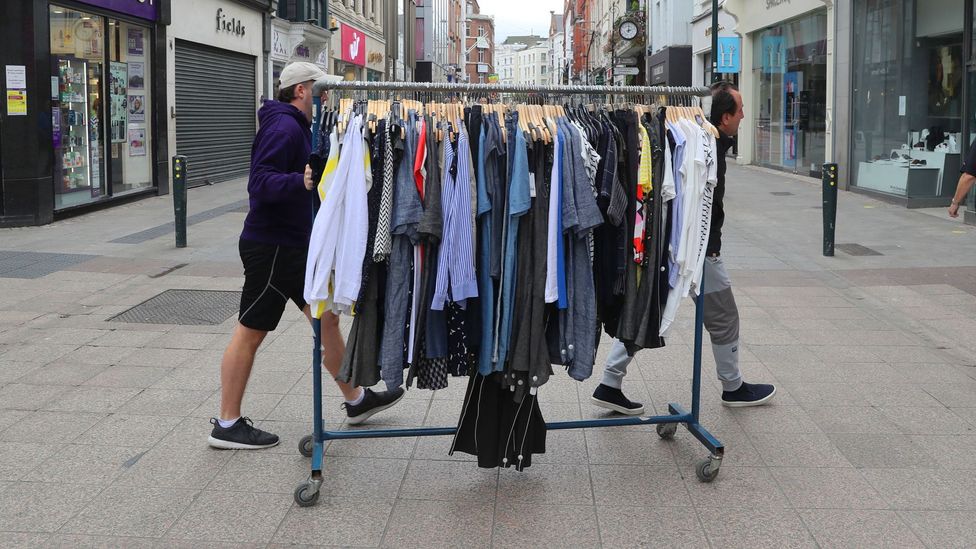
Fast fashion is leading to a mountain of clothing being thrown abroad each twelvemonth and has a huge impact on the environment, then tin can nosotros turn our unwanted garments into something useful?
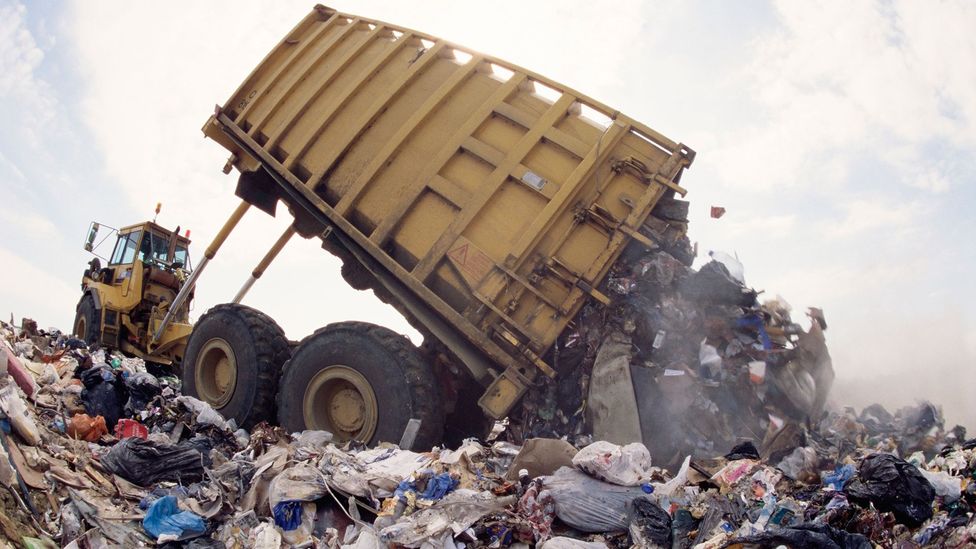
Millions of tonnes of clothing, shoes and other textiles stop upwardly in landfill every yr because very little is sent for recycling (Credit: Alamy)
"The current fashion system uses high volumes of non-renewable resources, including petroleum, extracted to produce clothes that are often used merely for a short menses of time, later on which the materials are largely lost to landfill or incineration," says Chetna Prajapati, who studies ways of making sustainable textiles at Loughborough University in the UK.
"This system puts pressure on valuable resources such equally water, pollutes the surround and degrades ecosystems in addition to creating societal impacts on a global scale."
There are practiced reasons to seek out alternatives to chucking clothes in the bin – globally the fashion industry is responsible for 10% of all greenhouse gas emissions, with cloth product alone is estimated to release 1.2 billion tonnes of greenhouse gases into the atmosphere every twelvemonth. Vast amounts of h2o are also needed to produce the clothes nosotros vesture as well and the style industry is responsible for twenty% of global waste water. (Read more well-nigh the impact our fashion addiction has on the planet .)
At the same time we are buying more dress than always – the average consumer now buys 60% more clothing than they did 15 years ago. More than than two tonnes of clothing are bought each minute in the UK, more than any other land in Europe. Globally, around 56 meg tonnes of clothing are bought each year, and this is expected to ascent to 93 million tonnes past 2030 and 160 one thousand thousand tonnes by 2050.
While most clothes with intendance will last many years, changing fashions mean their lifespan is artificially shortened by consumers changing tastes. Industry figures suggest modernistic habiliment will have a lifespan of between two-10 years – with underwear and t-shirts lasting just one to two years, while suits and coats last for around four to six years.
Would recycling our dress assist to reduce the toll our mode habit has on the environment?
Currently simply 13.6% of clothes and shoes thrown abroad in the US terminate up being recycled – while the average American throws away 37kg of clothes every year. Globally just 12% of the material used for clothing ends up beingness recycled. Compare that to paper, glass and plastic PET bottles – which accept recycling rates of 66%, 27% and 29% respectively in the The states – and it is articulate wearable lags behind.
Indeed, most of the recycled polyester existence used now by leading fashion brands in fact comes from bottles rather than former wearable.
Much of the trouble comes downward to what our wearing apparel are made from. The fabrics we drape over our bodies are complex combinations of fibres, fixtures and accessories. They are made from problematic blends of natural yarns, mand-fabricated filaments, plastics and metals.
"For example, a 100% cotton t-shirt contains many other components such every bit labels and sewing threads which are usually made from another fabric like polyester," says Prajapati. "Similarly, a typical pair of jeans are made from cotton yarn which is generally blended with elastane, and other components such as zips and buttons and polyester sewing thread and dyed using a range of dyes."
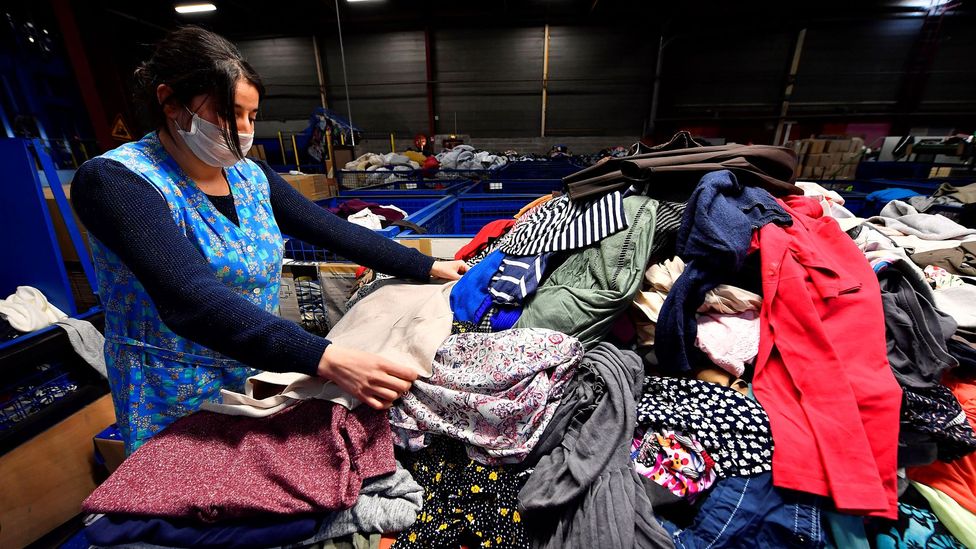
Sorting article of clothing past manus is a time consuming task made more complicated past the many blends of human-made and natural fibres used in modern garments (Credit: Getty Images)
This makes them hard to separate so they tin can be effectively recycled. Sorting textiles into unlike fibres and material types by hand is labour intensive, tedious and requires a skilled workforce. Growing use of modern fabric blends in vesture too makes it hard to practice this mechanically as well, although European researchers take been developing techniques that make use of hyperspectral cameras – which tin can see light across the limits of human being vision – to improve place unlike fabric types. Once sorted, the dyes that have been practical to the fabrics need to be removed in lodge for yarns to be reused.
Currently, withal, very few of the apparel that are sent to be recycled are really turned into new habiliment – a procedure known every bit "material to material" recycling. Old wool jumpers, for example, can be turned into carpets, cashmere can be recycled into suits. But as of 2015, less than 1% of used vesture was recycled in this mode.
While of grade there is a good for you market in second-hand clothes being sold online, perhaps the most popular way of disposing of one-time clothes is simply to give them away so they can be reused through charity shops. Increasingly, all the same, clothes donations are being used every bit a mode of simply passing on the textile waste trouble to others.
At Oxfam's Wastesaver wearing apparel sorting and recycling plant in Batley, Yorkshire, Great britain, eighty tonnes of former clothes pass through the factory every week. Lorraine Needham Reid, Oxfam'southward Wastesaver managing director, has worked at the plant for over 10 years. Over that time, however, she has seen a real decline in the quality of clothes that are reaching them, particularly when it comes to the materials used to brand the apparel.
These days, almost of what reaches Wastesaver will end up never being worn again. Over a 3rd – 35% of the apparel – go to Oxfam'southward partners in Senegal to be sold. Betwixt one-3% go back into Oxfam shops around the UK to be re-sold.
The bulk is sent for recycling in some way, merely about half dozen tonnes of the garments are of such poor quality they are but torn up so they can be used as industrial cleaning clothes and stuffing for mattresses or machine seats.
Fibre recycling technologies do exist, but they are only used on a small scale. Generally, the techniques can be separated into mechanical and chemical recycling.
"Blends are well-nigh suitable for mechanical fibre recycling, where fabrics are shredded and pulled to transform them into fibres of shorter length," says Prajapati. Shorter fibre length produces fabrics of lower quality and strength, then the results from this kind of recycling can't be used for vesture. Instead these tend to then be "downcycled" to produce other composite fibre materials such as thermal insulation or rug for use in the building manufacture. Some researchers accept constitute ways of creating racket insulation from erstwhile textile fibres.
Chemical fibre recycling for fabrics with big quantities of one blazon of fibre, for instance polyester and nylon are well established, says Prajapati. "Nonetheless, they consist of multiple processes and additional chemicals, making the process and resulting yarn or cloth costly," she says.
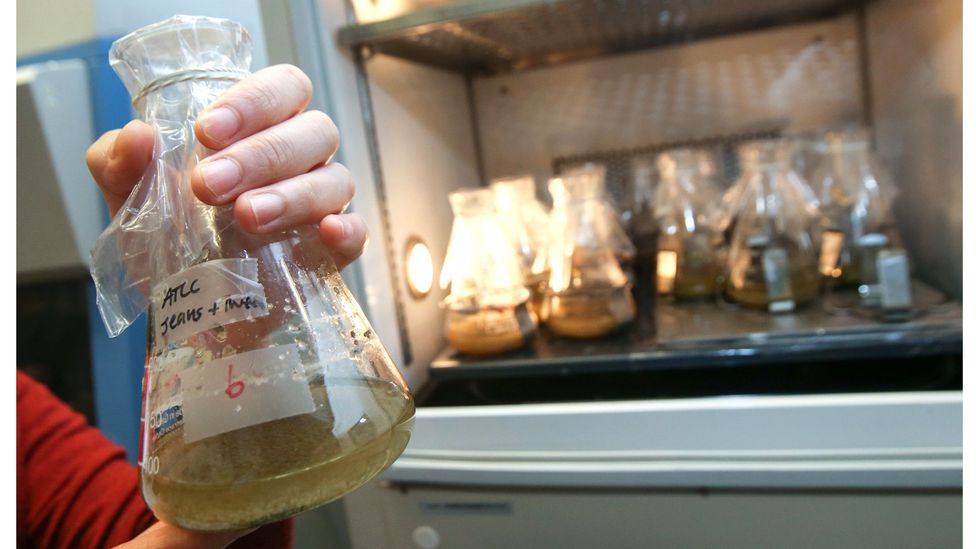
Treating cotton-polyester blends with enzymes from fungi tin recover the human being-made fibres for reuse (Credit: Getty Images)
At that place has been success on a smaller scale to effectively split up natural and constructed blends and capture both types of fibres, without losing either fibre in the process. Notwithstanding, scaling up this technology to an industrial calibration remains the claiming.
One group of researchers led past Ballad Lin, a chemical engineer at the Urban center University of Hong Kong, has developed a technique for recycling fabrics fabricated from cotton and polyester blends by feeding them to fungi. The fungi Aspergillus niger – which typically forms a blackness mould on grapes – produces an enzyme that can break downwards the cotton into glucose that can then be used turned into syrup. The remaining pure polyester fibres tin can then exist reused to brand new wearable, they claim. Poly-cotton blends are now among the most popular fabrics for use in inexpensive clothing, commonly used in t-shirts, shirts and even jeans.
Lin and her team have since refined the process so it can be done on a larger calibration using industrially produced cellulose enzymes, and accept been working with the clothing retailer H&Yard to examine what impact this recycling process might take on its textile waste.
Austrian researchers take also adult techniques using enzymes that allow them to turn erstwhile wool article of clothing into a textile that tin be used as a resin or agglutinative.
But if we e'er hope to brand our article of clothing sustainable, more than key changes to the clothing industry will need to be fabricated. Fabrics, fibres and garments will demand to be designed in ways that make them easier to recover and recycle.
"Recycling needs to be incorporated into the current organisation to make it more circular," says Prajapati. "Therefore, the way we design clothes needs to change, it needs to facilitate recycling."
One option is to create new types of materials altogether, from different sources, that either won't have the same impact on the environment or might be easier to recycle. Some are even looking at turning other types of waste matter – such equally off milk – into clothing.
When milk turns sour, information technology separates into whey at the bottom and protein flakes on summit. When y'all remove the whey, you are left with a kind of cottage cheese.
"This cottage cheese is put into a machine that works similar a noodle machine," says Anke Domaske, founder of QMilk, a company that has been developing new types of biodegradable fibres in Hemmingen, Federal republic of germany. "Together with water you create a dough. At the stop there is a spinneret with holes so fine that you do non finish up with noodles, but fine fibres that are thinner than hair."
The company and so spins these fibres into yarns, which information technology says have a silk-like texture. These can then be used to make jersey or woven fabrics, or other textiles like felt. Crucially, when a garment fabricated completely from QMilk fibres is no longer wanted, it can simply be composted at dwelling house, Domaske says.
QMilk isn't the but company creating textiles from unusual sources.
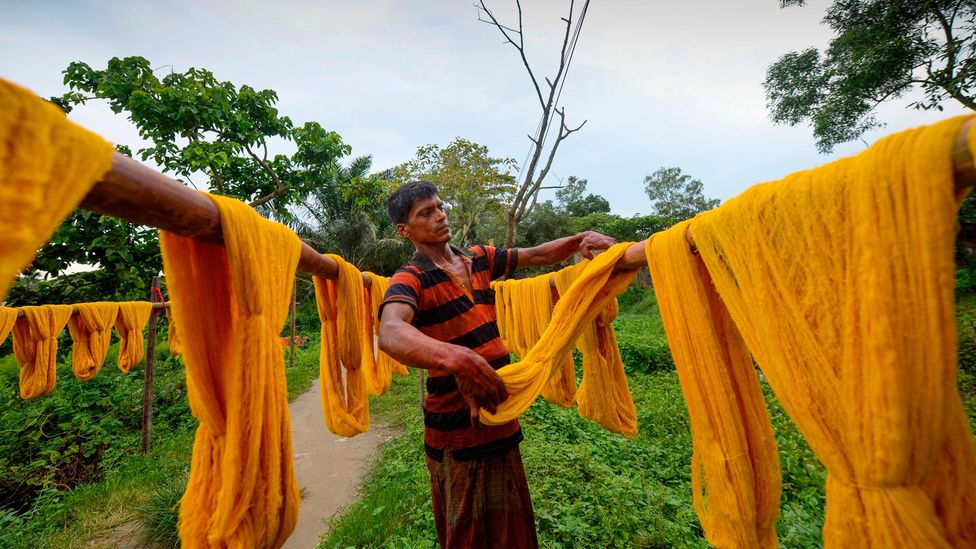
The dye that is added to clothing also needs to be removed before it the yarn tin can be recycled (Credit: Getty Images)
After working for years at a blueprint visitor in Germany, Renana Krebs saw behind the scenes how poor the textiles and clothing industry is for the environment. She vowed to do something about it and in 2016, she started Algalife, making fibres and dyes from algae.
Algae is already widely used in the beauty industry, in certain foods and it is used to make biofuels. "After learning well-nigh all those industries, and the benefits that we go from algae, we asked 'why not to exercise this for textiles?'" says Krebs.
One benefit is the algae are harvested in a closed system, pregnant there is no freshwater used in the process at all. All the algae need to grow is water and sunlight. Past extracting natural colourings from different types of algae, Krebs and her team have been able to combine these with enzymes and fixative agents – which help to bind the pigment to a cloth – from synthetic and natural sources, including oak galls, pomegranate rind and juniper needles.
They have also been able to produce fibres that can turned into yarns by purifying proteins from the algae or even using them to produce a bio-oil that can be turned into bioplastic fibres.
Prajapati has also been working with colleagues at De Montfort University to produce enzymes that could potentially make the clothes dying process more than sustainable.
Currently well-nigh textiles are coloured using synthetic dyes, which are petroleum derivatives, and patterned with complex processes. These processes can crave temperatures of up to 100C for cotton, nylon and wool, simply higher for polyester and other synthetic fibres. On peak of this, the procedure requires loftier pressures, long processing times and the apply of additional chemicals such equally acids and alkalis, which are harmful towards the environment in big quantities.
Prajapati and her colleagues accept been developing processes that use enzymes so that textile dyes and patterning of fabrics can be done temperatures as depression as 50C, at atmospheric pressure level and pH weather condition around neutral without the use of additional chemicals.
"The cardinal advantages over conventional methods include simpler processing of textiles, the elimination of pre-manufactured dyes and opportunities for multiple colours to exist achieved through uncomplicated alteration of processing weather condition," she says.
Pigments made by Algalife have similar benefits, plus the added benefit of existence created from renewable sources, says Krebs. You can even drink the dye they produce, she says. Algalife is at present working with a major retail fashion brand and hope to have wearing apparel made from algae in stores by 2021.
Other major brands across the fashion industry are starting to pay attention to the need for more sustainable practices. Companies like Adidas, that recently appear a range of trainers made from sea plastic. High street retailer Zara also appear in 2019 that it would exist using only sustainable materials past 2025.
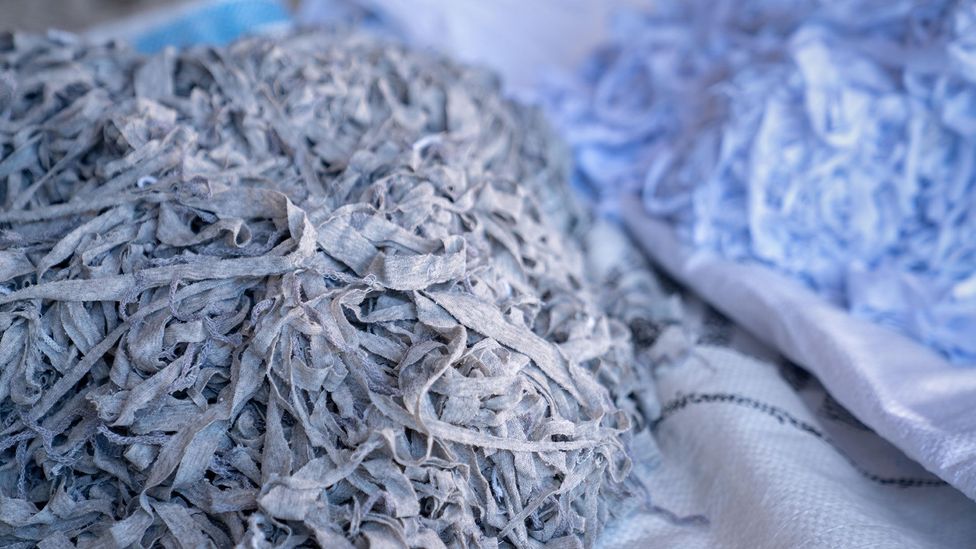
The shredding process used past mechanical recycling methods leads to shorter, weaker fibres that cannot be resued to make clothes (Credit: Alamy)
"Using recycled, rather than virgin, materials offers an opportunity to drastically reduce non-renewable resource inputs and the negative impacts of the manufacture, like CO2 emissions, h2o and chemical apply," says Prajapati.
But some are sceptical nearly how committed some large brands are to sustainability, accusing them of "greenwashing", which the companies deny.
Zara was one of the original inventors of the fast fashion system every bit nosotros know it, says Clare Press, Australian Vogue'due south sustainability editor-at-large and author of the volume Wardrobe Crisis. "Let'south not pretend people store at Zara for heirlooms to pass down through the generations," she says. "In the concluding 20 years the fashion system has changed completely, moving away from seasonal drops towards nearly-instant gratification. Waiting half-dozen months for a runway wait seems crazy to a new generation of fashion fans raised on Instagram and 'see now, buy at present'."
So while recycling and more sustainable fabrics will be a fundamental role of the solution, consumers too will need to change their behaviour if we hope to lessen the impact that the way industry is having on our planet.
"Nosotros need to slow down, take a lilliputian time to reconnect with our clothes and capeesh them again," says Press. "Remember that whatever y'all are wearing, it took both physical and artistic resources to make it."
--
Join ane million Future fans by liking u.s. on Facebook , or follow us on Twitter or Instagram .
If you liked this story, sign up for the weekly bbc.com features newsletter , chosen "The Essential List". A handpicked selection of stories from BBC Futurity, Civilisation, Worklife, and Travel, delivered to your inbox every Friday.
0 Response to "How Fast Fashion Adds to the World's Clothing Waste Problem"
Post a Comment